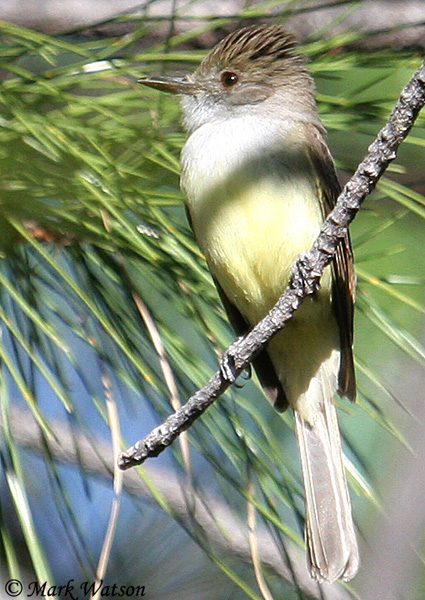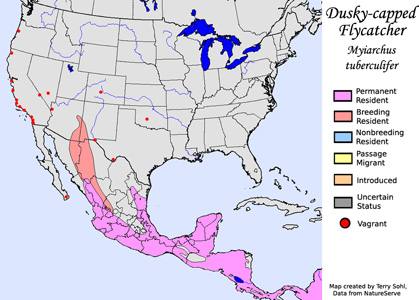| Length: 7.25 | Wingspan: 10 inches | Seasonality: Non-resident in South Dakota |
| ID Keys: Lemon-yellow belly, gray breast and neck, brownish-gray face and neck | ||
 The
Dusky-capped Flycatcher is one of a group of three potentially confusing
flycatcher species found in the southwestern United States. In some
parts of southern Arizona and New Mexico, they can be found in the same
areas as the similar
Brown-crested Flycatcher and
Ash-throated Flycatcher. The Dusky-capped Flycatcher can be
differentiated from those species by its smaller size, brownish-gray tones
on the head, and a much less colorful tail with a lack of the warm rufous
tones found in the other two species.
The
Dusky-capped Flycatcher is one of a group of three potentially confusing
flycatcher species found in the southwestern United States. In some
parts of southern Arizona and New Mexico, they can be found in the same
areas as the similar
Brown-crested Flycatcher and
Ash-throated Flycatcher. The Dusky-capped Flycatcher can be
differentiated from those species by its smaller size, brownish-gray tones
on the head, and a much less colorful tail with a lack of the warm rufous
tones found in the other two species.
Habitat: In the United States portion of its range, they are found in montane forests of oak or pine and oak, and in riparian forests. They can be found in a variety of forested habitats in their tropical range in Mexico and Central America.
Diet: Primarily feeds on insects, but will also feed on fruits and berries.
Behavior: Forages by observing from a perch, and flying out to capture insects in mid-air, or by hovering and gleaning insects from foliage or branches of vegetation.
Nesting: The nest of a Dusky-capped Flycatcher is built in a cavity of a tree, either an old woodpecker hole or a natural cavity. The nest itself is a mass of grasses, sticks, bark strips, roots, weeds, and leaves, lined with plant down, feathers, or other softer material. The female usually lays 4 or 5 eggs, and both parents help feed the young after they hatch. The young fledge after about 2 weeks.
Song: The song of a Dusky-capped Flycatcher is a series of mournful notes finished with a long trill...pidi tew tew pdrrrrrrrrrrr.
Migration: Considered a permanent resident in much of their range in Mexico and Central America. In the U.S. portion of their range, they are summer residents only.
Interactive eBird Map: Click here to access an interactive eBird map of Dusky-capped Flycatcher sightings
Similar Species: In range, most likely to be confused with the Ash-throated Flycatcher or Brown-crested Flycatcher.
Conservation Status: Populations may be decreasing, but they are still found over a wide geographic area and are common in parts of their range. The IUCN lists the Dusky-capped Flycatcher as a species of "Least Concern".
Further Information: 1) Audubon Guide - Dusky-capped Flycatcher
2) Texas Breeding Bird Atlas - Dusky-capped Flycatcher
3) Cornell's Neotropical Birds - Dusky-capped Flycatcher
Photo Information: Photo taken by Mark Watson - Photo licensed under Creative Commons Attribution NonCommercial NoDerivs 2.0 Generic License.
| Click below for a higher-resolution map |
 |
| South Dakota Status: Non-resident in South Dakota |
Additional Dusky-capped Flycatcher Photos (coming soon!!)
